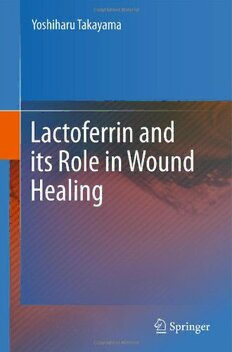
Lactoferrin and its Role in Wound Healing PDF
Preview Lactoferrin and its Role in Wound Healing
Lactoferrin and its Role in Wound Healing Yoshiharu Takayama Lactoferrin and its Role in Wound Healing Yoshiharu Takayama Functional Bio-molecules Research Team National Institute of Livestock and Grassland Science Ikenodai 2 305-0901 Tsukuba, Ibaraki Japan [email protected] ISBN 978-94-007-2466-2 e-ISBN 978-94-007-2467-9 DOI 10.1007/978-94-007-2467-9 Springer Dordrecht Heidelberg London New York Library of Congress Control Number: 2011939477 © Springer Science+Business Media B.V. 2012 No part of this work may be reproduced, stored in a retrieval system, or transmitted in any form or by any means, electronic, mechanical, photocopying, microfi lming, recording or otherwise, without written permission from the Publisher, with the exception of any material supplied specifi cally for the purpose of being entered and executed on a computer system, for exclusive use by the purchaser of the work. Printed on acid-free paper Springer is part of Springer Science+Business Media (www.springer.com) I dedicate this book to my father, Noboru Takayama, who passed away during the writing of this book. Preface Lactoferrin (lactotransferrin) was fi rst identifi ed as an iron-binding protein abundantly found in milk. It is synthesized by glandular epithelial cells and secreted into body fl uids such as saliva, tears and mucosal secretions. Lactoferrin has been considered to play important roles in host defense, since lactoferrin shows broad spectrum of anti- bacterial and anti-viral activities, arising from its iron-chelating property. However, some functions of lactoferrin are independent from its iron chelating ability. In addition, lactoferrin is known as a major component of secondary granules of neutrophils. Plasma lactoferrin concentration is dramatically increased by bacterial infection or tissue injury. Lactoferrin can regulate the function of innate and adaptive immune cells and exhibits immunoregulation activity. One of the most novel activity described for lactoferrin is its regulatory function in wound healing. The results of animal studies indicate that the topical administration of lactoferrin enhances the rate of skin wound closure in control and diabetic mice. Skin wound healing is a complex physiological process that requires the regulation of different types of cells such as immune cells, keratinocytes, fi broblasts, and endo- thelial cells. Infl ammation is prerequisite for wound healing. The promoting effect of lactoferrin on wound closure is likely to dependent on its immune regulatory function. In addition, the results of recent in vitro and in vivo studies show that lac- toferrin is a potent regulator of dermal fi broblasts and epidermal keratinocytes, and promotes skin or corneal epithelial wound healing by increasing their proliferation, migration or deposition of extracellular matrix (ECM) components such as collagen and hyaluronan. Hyaluronan (hyaluronic acid) is a glycosaminoglycan distributed throughout connective and epithelial tissues. The role of hyaluronan in wound heal- ing is the promotion of cell proliferation and motility. The aim of this book is to describe how lactoferrin directly or indirectly regulates the wound healing processes that consists of multiple steps. Lactoferrin exerts its biological effects by binding to specifi c lactoferrin receptors on target cells. The diverse functions result from activation of different receptors and signal transduction path- ways, and also from differences in the expression levels of receptors. This book will describe an overview of molecular basis of wound healing (Chap. 1 ), in addition to providing a general review of hyaluronan (Chap. 2 ) and lactoferrin (Chap. 3 ) and vii viii Preface role of lactoferrin as signaling mediator (Chap. 4 ). Finally, the effects of lactoferrin on wound healing are summarized in Chap. 5 . The multi-functionality of lactoferrin fosters usage of lactoferrin as a therapeutic agent for non-healing chronic wounds. A special feature of chronic wound is prolonged or excessive infl ammatory response at the wounded site. Current therapy using recombinant growth factor is partially effective for healing of chronic wounds. In the clinical trial of patients with diabetic foot ulcers, the group treated with human recombinant lactoferrin showed signifi cant improvement of wound healing rates compared with placebo group. Based on these fi ndings, lactoferrin should be used in patients with diabetic and other types of ulcers. Yoshiharu Takayama Contents 1 Molecular Regulation of Skin Wound Healing ...................................... 1 1.1 Introduction ...................................................................................... 1 1.2 Immediate Response ........................................................................ 2 1.3 Infl ammatory Response ................................................................... 3 1.4 Reepithelialization ........................................................................... 5 1.5 Granulation Tissue Formation.......................................................... 8 1.6 Wound Contraction .......................................................................... 8 1.7 Angiogenesis .................................................................................... 10 1.8 Remodeling ...................................................................................... 11 1.9 Resolution of Infl ammation ............................................................. 11 1.10 Proteases in Wound Healing ............................................................ 12 1.11 Anti-microbial Peptides ................................................................... 14 1.12 Chronic Wound Healing................................................................... 14 References ................................................................................................... 15 2 Role of Hyaluronan in Wound Healing ................................................... 25 2.1 Structure ........................................................................................... 25 2.2 Biosynthesis ..................................................................................... 26 2.3 Hyaluronan Receptor ....................................................................... 27 2.4 Mammalian Hyaluronidase .............................................................. 29 2.5 Hyaluronan Fragment ...................................................................... 30 2.6 Role on Cancer ................................................................................. 31 2.7 Hyaluronan in Dermis and Epidermis .............................................. 31 2.8 Role on Wound Healing ................................................................... 32 References ................................................................................................... 35 3 Lactoferrin Structure Function and Genetics ........................................ 43 3.1 Introduction ...................................................................................... 43 3.2 Lactoferrin Expression and Localization ......................................... 44 3.3 Lactoferrin Structure ........................................................................ 44 3.4 Iron-Binding Properties of Lactoferrin ............................................ 47 3.5 Lactoferrin Metabolism ................................................................... 47 ix
